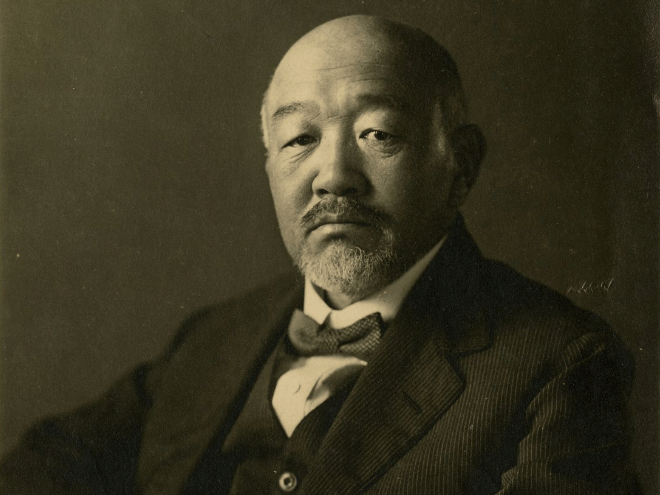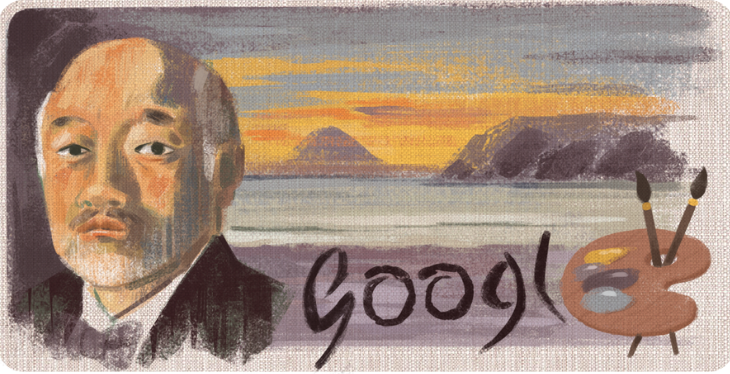Kuroda Seiki: Who was the celebrated painter who brought Western style to imperial Japan?
The son of a samurai studied in Paris before returning to his homeland and revolutionising the teaching and practice of painting

Japanese artist Kuroda Seiki is the subject of the latest Google Doodle on the 156th anniversary of his birth.
An influential painter of the late 19th and early 20th century, Seiki is credited with importing Western-style (or “yoga”) art theory to his homeland after studying his craft in Paris and developing what became his signature “Academic Impressionist” style.
He was born on 9 August 1866 in Takamibaba, Satsuma Domain (present day Kagoshima Prefecture), the son of a samurai, Kuroda Kiyokane, and his wife Yaeko.
Kuroda was adopted in 1871 by his paternal uncle, Kuroda Kiyotsuna, a powerful imperial government minister open to the modernising influences then beginning to arrive in Japan from overseas.
After learning French as a teenager, he was sent to Paris in the company of relatives in 1884 to study law.
There he met the expatriate artists Yamamoto Hosui and Fuji Masazo and art dealer Tadamasa Hayashi, who persuaded him to pursue his juvenile interest in painting, arguing he would be of more value to Japan in this capacity than he would as a lawyer.
After initially attempting to balance lessons in an art studio with his ongoing legal commitments, Kuroda was finally able to convince his adopted father to allow him to pursue the former exclusively, receiving tuition and encouragement from the painters Raphael Collin and Pierre Puvis de Chavannes, among others, and befriending fellow expatriate Kume Keiichiro.
In 1890, he left the city and headed south for an artist’s colony at Grez-sur-Loing, where he began to take inspiration from the landscapes of the French countryside.
By 1893, he was back in the capital and working on the painting “Morning Toilette”, which would become the first ever nude exhibited in Japan after he returned with it later that summer, creating a moral panic among mortified conservatives.
Tragically, the work was among many of Kuroda’s that would be lost forever in the destruction wrought by the Second World War, which began 15 years after the artist’s death.
Setting up in Kyoto, Kuroda began to apply the open-air style he had developed in Europe to familiar Japanese subjects, from ancient temples to geisha girls, creating something entirely new in the process.
He submitted several of his works to the Meiji Fine Arts Society’s annual exhibition, which displayed a number of his paintings in 1894, introducing him to a wider audience and winning him as many detractors as it did admirers, Kuroda’s use of bold colour to express the play of light across a landscape in particular presenting something of a culture shock.
That same year, he succeeded his old friend Yamamoto Hosui as head of the art school he had founded, renaming it the Tenshin Dojo and retraining its emphasis on the techniques he had developed in France.
The studio’s output proved to be at odds with the traditionalism of the Meiji Society, sparking a disagreement and inspiring Kuroda to break ties and found his own collective, known as the White Horse Society, after his preferred brand of sake, which preached artistic freedom from rules and formal constraints and staged its own exhibitions annually before disbanding in 1911.

During that period, Kuroda had been appointed director of the Tokyo School of Fine Arts, an academic setting that allowed him further scope to put his ideas across to students hungry to broaden their horizons, encouraging his pupils to get out of the studio, study anatomical drawing and sketch life models as part of the curriculum.
He also urged them to take inspiration from history painting and to apply his modern, Western approach to Japanese mythological subjects to express values of national importance like courage and valour.
By the turn of the century, Kuroda’s fame in Japan began to spread abroad and, completing the circle, his work was presented at the Paris Exposition Universelle in 1900, at which his celebrated painting “Lakeside”, depicting his wife Teruko passing the resort town of Hakone, was awarded a silver medal.
In 1911, Kuroda became the official painter to Japan’s imperial court and inherited his late adopted father’s title of viscount upon the latter’s death six years later.
In 1920, he was elected to Tokyo’s House of Lords, in 1922 he was appointed head of the Imperial Fine Arts Academy and, in 1923, the French government recognised his contribution by awarding him the prestigious Grand Cross of the Legion d’Honneur.
Viscount Kuroda Seiki passed away at home in Azabu on 15 July 1924 and was posthumously awarded the Order of the Rising Sun.
Join our commenting forum
Join thought-provoking conversations, follow other Independent readers and see their replies
Comments


Bookmark popover
Removed from bookmarks